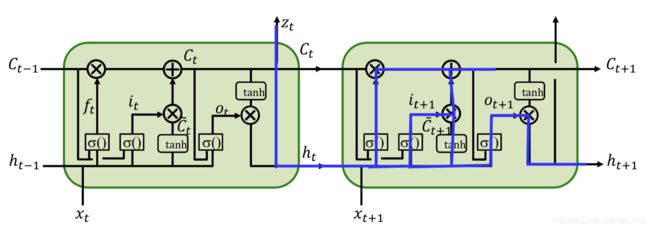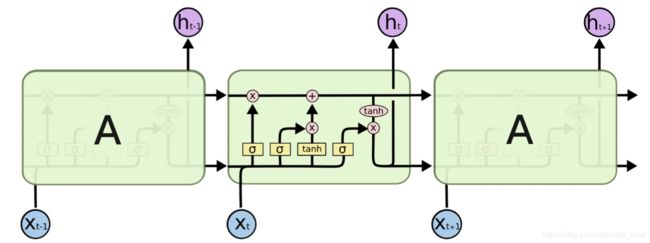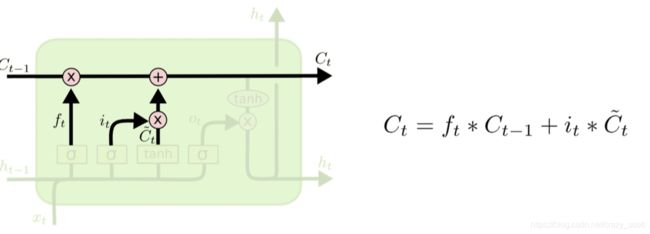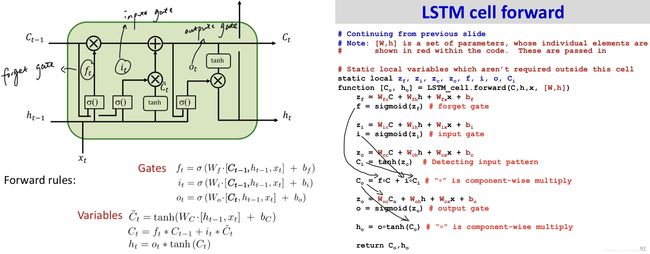CMU 11-785 L14 Stability analysis and LSTMs
Stability
- Will this necessarily be「Bounded Input Bounded Output」?
- Guaranteed if output and hidden activations are bounded
- But will it saturate?
Analyzing Recursion
-
Sufficient to analyze the behavior of the hidden layer since it carries the relevant information
-
Assumed linear systems
- z k = W h h k − 1 + W x x k , h k = z k z_{k}=W_{h} h_{k-1}+W_{x} x_{k}, \quad h_{k}=z_{k} zk=Whhk−1+Wxxk,hk=zk
- Sufficient to analyze the response to a single input at t = 0 t =0 t=0 (else is zero input)
Simple scalar linear recursion
- h ( t ) = w h ( t − 1 ) + c x ( t ) h(t) = wh(t-1) + cx(t) h(t)=wh(t−1)+cx(t)
- h 0 ( t ) = w t c x ( 0 ) h_0(t) = w^tcx(0) h0(t)=wtcx(0)
- If w > 1 w > 1 w>1 it will blow up
Simple Vector linear recursion
- h ( t ) = W h ( t − 1 ) + C x ( t ) h(t) = Wh(t-1) + Cx(t) h(t)=Wh(t−1)+Cx(t)
- h 0 ( t ) = W t C x ( 0 ) h_0(t) = W^tCx(0) h0(t)=WtCx(0)

- For any input, for large the length of the hidden vector will expand or contract according to the t − t- t− th power of the largest eigen value of the hidden-layer weight matrix
- If ∣ λ m a x > 1 ∣ |\lambda_{max} > 1| ∣λmax>1∣ it will blow up, otherwise it will contract and shrink to 0 rapidly
Non-linearities
- Sigmoid: Saturates in a limited number of steps, regardless of w w w
- To a value dependent only on w w w (and bias, if any)
- Rate of saturation depends on w w w
- Tanh: Sensitive to w w w, but eventually saturates
- “Prefers” weights close to 1.0
- Relu: Sensitive to w w w, can blow up
Lessons
- Recurrent networks retain information from the infinite past in principle
- In practice, they tend to blow up or forget
- If the largest Eigen value of the recurrent weights matrix is greater than 1, the network response may blow up
- If it’s less than one, the response dies down very quickly
- The “memory” of the network also depends on the parameters (and activation) of the hidden units
- Sigmoid activations saturate and the network becomes unable to retain new information
- RELU activations blow up or vanish rapidly
- Tanh activations are the most effective at storing memory
- And still has very short “memory”
- Still sensitive to Eigenvalues of W W W
Vanishing gradient
- A particular problem with training deep networks is the gradient of the error with respect to weights is unstable
- For
- Div ( X ) = D ( f N ( W N − 1 f N − 1 ( W N − 2 f N − 2 ( … W 0 X ) ) ) ) \operatorname{Div}(X)=D\left(f_{N}\left(W_{N-1} f_{N-1}\left(W_{N-2} f_{N-2}\left(\ldots W_{0} X\right)\right)\right)\right) Div(X)=D(fN(WN−1fN−1(WN−2fN−2(…W0X))))
- We get
- ∇ f k Div = ∇ D . ∇ f N . W N − 1 . ∇ f N − 1 . W N − 2 … ∇ f k + 1 W k \nabla_{f_{k}} \operatorname{Div}=\nabla D . \nabla f_{N} . W_{N-1} . \nabla f_{N-1} . W_{N-2} \ldots \nabla f_{k+1} W_{k} ∇fkDiv=∇D.∇fN.WN−1.∇fN−1.WN−2…∇fk+1Wk
- Where
- ∇ f n \nabla{f_{n}} ∇fn is jacobian of f N ( ) f_N() fN() to its current input
For activation
- For RNN
- ∇ f t ( z i ) = [ f t , 1 ′ ( z 1 ) 0 ⋯ 0 0 f t , 2 ′ ( z 2 ) ⋯ 0 ⋮ ⋮ ⋱ ⋮ 0 0 ⋯ f t , N ′ ( z N ) ] \nabla f_{t}\left(z_{i}\right)=\left[\begin{array}{cccc}f_{t, 1}^{\prime}\left(z_{1}\right) & 0 & \cdots & 0 \\\\ 0 & f_{t, 2}^{\prime}\left(z_{2}\right) & \cdots & 0 \\\\ \vdots & \vdots & \ddots & \vdots \\\\ 0 & 0 & \cdots & f_{t, N}^{\prime}\left(z_{N}\right)\end{array}\right] ∇ft(zi)=⎣⎢⎢⎢⎢⎢⎢⎢⎢⎢⎡ft,1′(z1)0⋮00ft,2′(z2)⋮0⋯⋯⋱⋯00⋮ft,N′(zN)⎦⎥⎥⎥⎥⎥⎥⎥⎥⎥⎤
- For vector activations: A full matrix
- For scalar activations: A matrix where the diagonal entries are the derivatives of the activation of the recurrent hidden layer
- The derivative (or subgradient) of the activation function is always bounded
- Most common activation functions, such as sigmoid, tanh() and RELU have derivatives that are always less than 1
- Multiplication by the Jacobian is always a shrinking operation
- After a few layers the derivative of the divergence at any time is totally “forgotten”
For weights
- In a single-layer RNN, the weight matrices are identical
- The conclusion below holds for any deep network, though
- The chain product for ∇ f k D i v \nabla_{f_k} Div ∇fkDiv will
- Expand ∇ D \nabla D ∇D along directions in which the singular values of the weight matrices are greater than 1
- Shrink ∇ D \nabla D ∇D in directions where the singular values are less than 1
- Repeated multiplication by the weights matrix will result in Exploding or vanishing gradients
LSTM
Problem
- Recurrent nets are very deep nets
- Stuff gets forgotten in the forward pass too
- Each weights matrix and activation can shrink components of the input
- Need the long-term dependency
- The memory retention of the network depends on the behavior of the weights and jacobian
- Which in turn depends on the parameters W W W rather than what it is trying to remember
- We need
- Not be directly dependent on vagaries of network parameters, but rather on input-based determination of whether it must be remembered
- Retain memories until a switch based on the input flags them as ok to forget
- 「Curly brace must remember until curly brace is closed」
Architecture
- The σ \sigma σ are multiplicative gates that decide if something is important or not
Key component
Remembered cell state
- Mutiply is a switch
- Should I continue remember or not? (scale up / down)
- Acddition
- Should I agument the memory?
- C t C_t Ct is the linear history carried by the constant-error carousel
- Carries information through, only affected by a gate
- And addition of history, which too is gated…
Gates
- Gates are simple sigmoidal units with outputs in the range (0,1)
- Controls how much of the information is to be let through
Forget gate
- The first gate determines whether to carry over the history or to forget it
- More precisely, how much of the history to carry over
- Also called the “forget” gate
- Note, we’re actually distinguishing between the cell memory C C C and the state h h h that is coming over time! They’re related though
- Hidden state is compute from memory (which is stored)
Input gate
- The second input has two parts
- A perceptron layer that determines if there’s something new and interesting in the input
- 「See a curly brace」
- A gate that decides if its worth remembering
- 「Curly brace is in comment section, ignore it」
- A perceptron layer that determines if there’s something new and interesting in the input
Memory cell update
- If something new and worth remembering
- Added to the current memory cell
Output and Output gate
- The output of the cell
- Simply compress it with tanh to make it lie between 1 and -1
- Note that this compression no longer affects our ability to carry memory forward
- Controlled by an output gate
- To decide if the memory contents are worth reporting at this time
- Simply compress it with tanh to make it lie between 1 and -1
The “Peephole” Connection
- The raw memory is informative by itself and can also be input
- Note, we’re using both C C C and h h h
Forward
Backward1

∇ C t D i v = ∇ h t D i v ∘ ( o t ∘ tanh ′ ( . ) + tanh ( . ) ∘ σ ′ ( . ) W C o ) + ∇ C t + 1 D i v ∘ ( f t + 1 + C t ∘ σ ′ ( . ) W C f + C ~ t + 1 ∘ σ ′ ( . ) W C i ∘ tanh ( . ) … ) \begin{array}{l} \nabla_{C_{t}} D i v=&\nabla_{h_{t}} D i v \circ\left(o_{t} \circ \tanh ^{\prime}(.)+\tanh (.) \circ \sigma^{\prime}(.) W_{C o}\right)+ \\\\ &\nabla_{C_{t+1}} D i v \circ\left(f_{t+1}+C_{t} \circ \sigma^{\prime}(.) W_{C f}+\tilde{C}_{t+1} \circ \sigma^{\prime}(.) W_{C i} \circ \tanh (.) \ldots\right) \end{array} ∇CtDiv=∇htDiv∘(ot∘tanh′(.)+tanh(.)∘σ′(.)WCo)+∇Ct+1Div∘(ft+1+Ct∘σ′(.)WCf+C~t+1∘σ′(.)WCi∘tanh(.)…)

∇ h t D i v = ∇ z t D i v ∇ h t z t + ∇ C t + 1 D i v ∘ ( C t ∘ σ ′ ( . ) W h f + C ~ t + 1 ∘ σ ′ ( . ) W h i ) + ∇ C t + 1 D i v ∘ o t + 1 ∘ tanh ′ ( . ) W h i + ∇ h t + 1 D i v ∘ tanh ( . ) ∘ σ ′ ( . ) W h o \begin{aligned} \nabla_{h_{t}} D i v=& \nabla_{z_{t}} D i v \nabla_{h_{t}} z_{t}+\nabla_{C_{t+1}} D i v \circ\left(C_{t} \circ \sigma^{\prime}(.) W_{h f}+\tilde{C}_{t+1} \circ \sigma^{\prime}(.) W_{h i}\right)+\\\\ &\nabla_{C_{t+1}} D i v \circ o_{t+1} \circ \tanh ^{\prime}(.) W_{h i}+\nabla_{h_{t+1}} D i v \circ \tanh (.) \circ \sigma^{\prime}(.) W_{h o} \end{aligned} ∇htDiv=∇ztDiv∇htzt+∇Ct+1Div∘(Ct∘σ′(.)Whf+C~t+1∘σ′(.)Whi)+∇Ct+1Div∘ot+1∘tanh′(.)Whi+∇ht+1Div∘tanh(.)∘σ′(.)Who
And weights?
Gated Recurrent Units
- Combine forget and input gates
- In new input is to be remembered, then this means old memory is to be forgotten
- No need to compute twice
- Don’t bother to separately maintain compressed and regular memories
- Redundant representation
Summary
- LSTMs are an alternative formalism where memory is made more directly dependent on the input, rather than network parameters/structure
- Through a “Constant Error Carousel” memory structure with no weights or activations, but instead direct switching and “increment/decrement” from pattern recognizers
- Do not suffer from a vanishing gradient problem but do suffer from exploding gradient issue
http://arunmallya.github.io/writeups/nn/lstm/index.html#/ ↩︎













